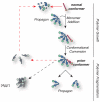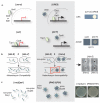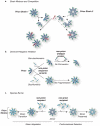The prion hypothesis: from biological anomaly to basic regulatory mechanism
- PMID: 21081963
- PMCID: PMC3003427
- DOI: 10.1038/nrm3007
The prion hypothesis: from biological anomaly to basic regulatory mechanism
Abstract
Prions are unusual proteinaceous infectious agents that are typically associated with a class of fatal degenerative diseases of the mammalian brain. However, the discovery of fungal prions, which are not associated with disease, suggests that we must now consider the effect of these factors on basic cellular physiology in a different light. Fungal prions are epigenetic determinants that can alter a range of cellular processes, including metabolism and gene expression pathways, and these changes can lead to a range of prion-associated phenotypes. The mechanistic similarities between prion propagation in mammals and fungi suggest that prions are not a biological anomaly but instead could be a newly appreciated and perhaps ubiquitous regulatory mechanism.
Figures




Comment in
-
Conformational conversion and prion disease.Nat Rev Mol Cell Biol. 2011 Apr;12(4):273; author reply 273. doi: 10.1038/nrm3007-c1. Nat Rev Mol Cell Biol. 2011. PMID: 21427768 No abstract available.
Similar articles
-
Fungal prions.Prog Mol Biol Transl Sci. 2012;107:417-56. doi: 10.1016/B978-0-12-385883-2.00007-2. Prog Mol Biol Transl Sci. 2012. PMID: 22482457 Review.
-
Amyloid formation of a yeast prion determinant.J Mol Neurosci. 2004;23(1-2):13-22. doi: 10.1385/JMN:23:1-2:013. J Mol Neurosci. 2004. PMID: 15126688 Review.
-
Is loss of function of the prion protein the cause of prion disorders?Trends Mol Med. 2003 Jun;9(6):237-43. doi: 10.1016/s1471-4914(03)00069-8. Trends Mol Med. 2003. PMID: 12829011
-
Prions: structure, function, evolution, and disease.Arch Microbiol. 2024 Nov 22;207(1):1. doi: 10.1007/s00203-024-04200-3. Arch Microbiol. 2024. PMID: 39572454 Review.
-
Propagating prions in fungi and mammals.Mol Cell. 2004 Jun 4;14(5):541-52. doi: 10.1016/j.molcel.2004.05.012. Mol Cell. 2004. PMID: 15175150 Review.
Cited by
-
Functional diversification of hsp40: distinct j-protein functional requirements for two prions allow for chaperone-dependent prion selection.PLoS Genet. 2014 Jul 24;10(7):e1004510. doi: 10.1371/journal.pgen.1004510. eCollection 2014 Jul. PLoS Genet. 2014. PMID: 25058638 Free PMC article.
-
Prions, amyloids, and RNA: Pieces of a puzzle.Prion. 2016 May 3;10(3):182-206. doi: 10.1080/19336896.2016.1181253. Prion. 2016. PMID: 27248002 Free PMC article. Review.
-
Generalizing a mathematical model of prion aggregation allows strain coexistence and co-stability by including a novel misfolded species.J Math Biol. 2019 Jan;78(1-2):465-495. doi: 10.1007/s00285-018-1280-4. Epub 2018 Aug 16. J Math Biol. 2019. PMID: 30116882 Free PMC article.
-
Protein rescue from aggregates by powerful molecular chaperone machines.Nat Rev Mol Cell Biol. 2013 Oct;14(10):617-29. doi: 10.1038/nrm3660. Nat Rev Mol Cell Biol. 2013. PMID: 24061228 Review.
-
Measuring prion propagation in single bacteria elucidates a mechanism of loss.Proc Natl Acad Sci U S A. 2023 Sep 26;120(39):e2221539120. doi: 10.1073/pnas.2221539120. Epub 2023 Sep 22. Proc Natl Acad Sci U S A. 2023. PMID: 37738299 Free PMC article.
References
Publication types
MeSH terms
Substances
Grants and funding
LinkOut - more resources
Full Text Sources

